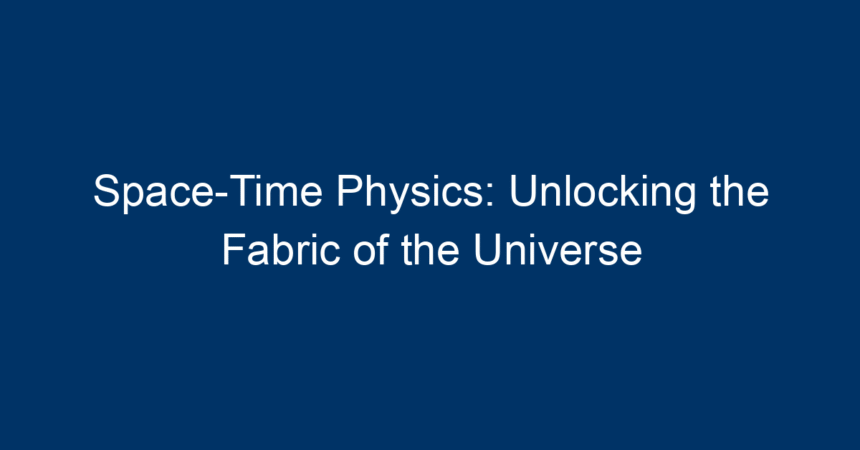Introduction
Space-time physics is a captivating domain that seeks to decode the very essence of our universe. By interweaving the dimensions of space and time, this field reveals profound insights into the nature of reality, altering our understanding of everything from gravity to cosmology. As we embark on this exploratory journey, we’ll uncover the principles that govern space-time physics, understand its implications, and consider its vast applications in our daily lives.
What is Space-Time Physics?
Understanding the Basics
At its core, space-time physics blends the three dimensions of space—length, width, and height—with the fourth dimension: time. This revolutionary concept, first popularized by Albert Einstein through his theory of relativity, transforms our perception of gravitational forces and cosmic phenomena. In essence, rather than viewing space and time as separate entities, space-time physics considers them as a single, interconnected fabric.
The Einsteinian Revolution
Einstein’s Special and General Relativity are pivotal in the realm of space-time physics. Special Relativity, introduced in 1905, emphasizes that the laws of physics are the same for all observers, regardless of their motion. In contrast, General Relativity, formulated in 1915, provides a comprehensive theory of gravity as a curvature of space-time caused by mass.
The Fabric of Space-Time
Curvature and Gravity
One of the cornerstone principles of space-time physics is that massive objects, such as planets and stars, warp the fabric of space-time around them. This curvature explains why objects fall toward one another; they are following the bent contours of the space-time continuum. It’s akin to placing a heavy ball on a stretched rubber sheet—the ball indents the sheet, causing smaller objects to roll towards it.
The Role of Light
Light plays a crucial role in space-time physics. According to the theory, the speed of light is constant in a vacuum and serves as a cosmic speed limit. This invariant speed leads to fascinating concepts like time dilation, where time moves slower in strong gravitational fields or at high velocities, significantly altering our perception of reality as observed from different frames of reference.
Time and Its Nature
Does Time Exist?
Space-time physics leads us to ponder the essence of time itself. Is it a fundamental aspect of the universe? Or is it merely an illusion, a human construct? In the realm of space-time, time is intertwined with space, suggesting that the past, present, and future coexist in a broader dimensional sense. This notion challenges our traditional understanding and raises philosophical questions about free will, determinism, and the nature of existence.
Time Dilation: A Relativity Phenomenon
Time dilation is one of the most remarkable implications of space-time physics. As described in Einstein’s theories, when an object travels close to the speed of light or is situated in a strong gravitational field, time appears to slow down for it in relation to a stationary observer. This phenomenon has been experimentally verified using atomic clocks on fast-moving jets and those placed under significant gravitational influence.
Space-Time and Black Holes
The Singularity
One of the most intriguing consequences of space-time physics is the formation of black holes. These astronomical entities arise when massive stars collapse under their gravity, creating a singularity—a region where density becomes infinite and the laws of physics as we know them cease to operate. Understanding black holes helps scientists grapple with the limits of our current knowledge and explore the very boundaries of space-time.
Event Horizons and Time Travel
The event horizon of a black hole marks the point of no return, beyond which not even light can escape. Interestingly, theories about wormholes, theoretical passages through space-time, suggest potential avenues for time travel. While these ideas remain speculative, they ignite fascination and inspire future scientific inquiry.
The Expanding Universe
Cosmological Implications of Space-Time Physics
Space-time physics also extends to the very fabric of our universe, revealing the dynamic interplay of expansion and cosmic evolution. The Big Bang theory posits that the universe began as a singular point, expanding over billions of years and shaping the cosmos we perceive today.
Dark Energy and Space-Time
Observations indicate that the rate of the universe’s expansion is accelerating, a phenomenon attributed to dark energy—an enigmatic force that constitutes about 68% of the universe. The relationship between dark energy and space-time physics poses challenging questions about the fate of our universe, compelling research into the very nature of existence.
Everyday Applications of Space-Time Physics
GPS Technology
The practical implications of space-time physics transcend theoretical discussions. A prime example is the Global Positioning System (GPS). Satellite-based navigation systems rely on precise timing, which must account for time dilation. Without adjustments for the effects of relativity, GPS calculations would quickly become inaccurate, leading to navigational errors.
Medical Imaging and Particle Physics
In medicine, technologies like MRI and CT scans utilize principles derived from space-time physics. Additionally, particle accelerators like the Large Hadron Collider (LHC) depend on relativistic phenomena, allowing scientists to probe fundamental questions about matter and energy.
Conclusion
Space-time physics presents an awe-inspiring framework for understanding the universe. From the nature of gravity to the very essence of time, it challenges our perceptions and reshapes our relationships with the cosmos. As we continue to explore this expansive field, we uncover the potential to unlock further mysteries of our universe.
Actionable Insights
-
Engage with the Community: Join local or online forums discussing physics; sharing insights can deepen understanding.
-
Further Your Education: Explore courses in physics and cosmology, available through universities or platforms like Coursera and edX.
-
Stay Informed: Keep up with recent developments in space-time physics by following reputable science journals and news outlets.
- Experiment with Thought: Engage with thought experiments related to relativity and space-time. Exploring these concepts can enhance your critical thinking skills.
As we continue to unravel the complexities of space-time physics, we invite curious minds to engage, explore, and participate in the scientific discourse that shapes our understanding of the universe.




